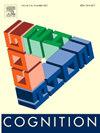Are your eyes following your thoughts? Exploring individual differences in internal coupling
IF 2.8
1区 心理学
Q1 PSYCHOLOGY, EXPERIMENTAL
引用次数: 0
Abstract
The eyes are remarkably active during internal cognitive processes and often couple to internal events, but there is substantial interindividual variability in the amount of this internal coupling. These variations present considerable challenges for predicting cognitive states and raise important theoretical questions about their origins. This study explores whether internal coupling serves as a compensation mechanism to supports internal activities when task demands exceed individual's cognitive resources or if internal coupling occurs as a byproduct of mental imagery, with its co-occurrence determined by the quality of an individual's mental image.
We examined how consistently eye movements aligned with imagined movement in a visuospatial working memory task and related these coupled saccades to measures of working memory capacity (Complex span tasks) and imagery skills (VVIQ, OSIVQ). We found that the rate of coupled saccades, when the task was performed entirely in mind, ranged from zero to 90 %. The data showed some indications that people with lower working memory capacity and lower vividness of visual imagination might benefit from internal coupling, hinting at some functional and compensatory role of coupling. However, these results were not robust, and no adaptive response to increased task demands was observed, challenging the notion of strategic use of internal coupling. The quality of mental imagery influenced internal coupling, with the removal of a visual spatial reference reducing coupling frequency, especially in those participants with lower spatial working memory capacity. Overall, while internal coupling is partly related to functional aspects and the quality of mental images, a substantial portion of individual differences remained unexplained, highlighting the need for further research into the role of eye movements during internal cognitive processes.
你的眼睛跟随你的思想吗?探索内部耦合的个体差异
眼睛在内部认知过程中非常活跃,并且经常与内部事件相关联,但是这种内部耦合的数量在个体之间存在很大的差异。这些变化对预测认知状态提出了相当大的挑战,并对其起源提出了重要的理论问题。本研究探讨了当任务需求超过个体认知资源时,内部耦合是否作为一种补偿机制来支持内部活动,或者内部耦合是否作为心理意象的副产品而发生,其共存取决于个体心理意象的质量。我们研究了在视觉空间工作记忆任务中眼球运动与想象运动的一致性,并将这些耦合的扫视与工作记忆容量(复杂跨度任务)和图像技能(VVIQ, OSIVQ)的测量相关联。我们发现,当任务完全在头脑中执行时,耦合扫视率从0到90%不等。这些数据表明,工作记忆容量较低和视觉想象生动度较低的人可能受益于内部耦合,暗示了耦合的某种功能和补偿作用。然而,这些结果并不稳健,并且没有观察到对增加的任务需求的自适应反应,这挑战了战略使用内部耦合的概念。心理意象的质量影响内部耦合,去除视觉空间参考会降低耦合频率,特别是在那些空间工作记忆容量较低的参与者中。总的来说,虽然内部耦合部分与功能方面和心理图像的质量有关,但很大一部分个体差异仍未得到解释,这突出表明需要进一步研究眼动在内部认知过程中的作用。
本文章由计算机程序翻译,如有差异,请以英文原文为准。
求助全文
约1分钟内获得全文
求助全文
来源期刊

Cognition
PSYCHOLOGY, EXPERIMENTAL-
CiteScore
6.40
自引率
5.90%
发文量
283
期刊介绍:
Cognition is an international journal that publishes theoretical and experimental papers on the study of the mind. It covers a wide variety of subjects concerning all the different aspects of cognition, ranging from biological and experimental studies to formal analysis. Contributions from the fields of psychology, neuroscience, linguistics, computer science, mathematics, ethology and philosophy are welcome in this journal provided that they have some bearing on the functioning of the mind. In addition, the journal serves as a forum for discussion of social and political aspects of cognitive science.
 求助内容:
求助内容: 应助结果提醒方式:
应助结果提醒方式:


